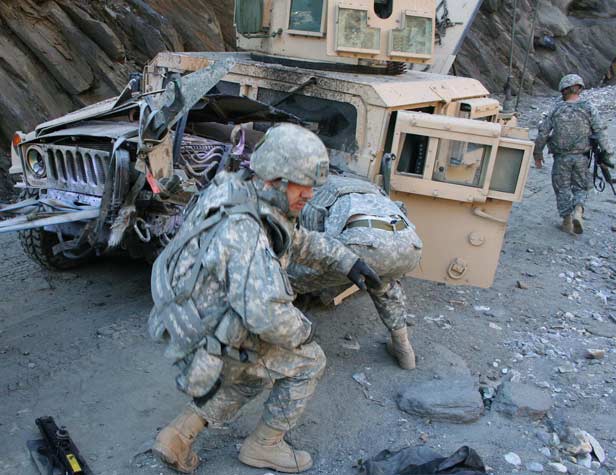The Mechanics of Blast Injuries

Scientists have discovered a mechanism underlying the type of brain injury that soldiers often suffer as a result of roadside explosions in Iraq and Afghanistan. The work could point the way toward early treatment for these acute blast injuries by identifying potential drug targets.
Two new papers from the Disease Biophysics Group at Harvard’s School of Engineering and Applied Sciences and Wyss Institute for Biologically Inspired Engineering, led by Kevin “Kit” Parker, use tissue-engineering techniques to model the physical and biochemical effects of traumatic brain injury (TBI) in the brain and blood vessels. Parker says the work represents a first step toward a “TBI on a chip” that could be used to screen for drugs to treat blast-injured soldiers before long-term damage sets in.
TBI induced by blasts from improvised explosive devices and rocket-propelled grenades is the most common injury among soldiers in Iraq and Afghanistan. Even mild TBI is an insidious injury, because it damages the brain in ways that aren’t immediately apparent and that physicians currently can do little to treat. It’s commonly believed that the injury damages the brain by stretching neurons to their breaking point, ripping small holes in the cell membrane that eventually kill the cells. But Parker says his team found that it wasn’t necessary to harm the membrane to induce TBI-like injuries in the cell.
Both papers focus on integrins, a type of cell-membrane protein that translates the mechanical forces of injury into internal changes in the cell. The researchers subjected cells to brief, abrupt forces. Such systems have been used in the past, but Parker’s team used forces that weren’t powerful enough to physically rip the cell. They found that this could cause the same kinds of structural changes in both neurons and blood vessel cells as those seen in the brains of people with TBI.
David Hovda, who directs the Brain Injury Research Center at University of California Los Angeles, says the studies will lead people who have been working on TBI to think about these injuries in a new way. He also believes that the findings could potentially apply to people with other kinds of brain injuries, although the difference between blasts and other traumas is currently controversial. However, Hovda says that like other studies on isolated cells, they may or may not really capture what’s happening in the brain. “Trauma is the most complicated form of injury, and the brain is the most complicated organ,” he says. He says that more studies and autopsies on wounded soldiers must be conducted to understand the effects of blasts in human brains.
In one of the papers, published in today in PLoS One, the researchers attached magnetic beads to integrin complexes that act as a kind of structural anchor in cells, along the axons of neurons. They found that just a small force applied to the beads was necessary to injure axons. Furthermore, the forces on one bead would propagate through the cell’s skeleton down another axon, causing the distant axon to break or be injured. Parker says the propagation of forces through neurons explains why damage to axons can be seen even far from the injury site in human brains.
The other paper, published last week in Proceedings of the National Academy of Sciences, shows that integrins can also mediate a problem called cerebral vasospasm, a narrowing of blood-vessel openings that begins days to months after a blast injury. Parker explains that while vasospasm can occur when blood vessels break and bleed out, sometimes there is no bleeding and another process must be in play. His team engineered arteries from blood-vessel cells and studied the effects of blast-like stretching. “We found that within 24 hours, the blast had induced the flip of a genetic switch,” he says. That creates chemical and physical changes characteristic of cells in cerebral vasospasm.
In both the neurons and the blood-vessel cells, treating cells with a drug that inhibits a protein activated by integrins lessened the injury. Parker believes that targeting this or similar chemical pathways could be a way to treat soldiers directly after blasts, in order to prevent some of the slower biochemical effects that follow from the initial trauma.
Parker, a major in the U.S. Army who served in Afghanistan, normally works on other biophysics problems but got involved in the project after spending time on a battlefield with Colonel Geoffrey Ling, a U.S. Army neurologist specializing in brain trauma; Ling is now a program manager at the Defense Advanced Research Projects Agency (DARPA), where he directs efforts to fund research into the science of TBI. Because it’s very difficult to know what’s happening in the brains of injured soldiers, Parker says, we need another way of studying the problem: “If you don’t build models for IED blasts, then it’s going to be difficult to get people to come into this field.”
Keep Reading
Most Popular
Large language models can do jaw-dropping things. But nobody knows exactly why.
And that's a problem. Figuring it out is one of the biggest scientific puzzles of our time and a crucial step towards controlling more powerful future models.
How scientists traced a mysterious covid case back to six toilets
When wastewater surveillance turns into a hunt for a single infected individual, the ethics get tricky.
The problem with plug-in hybrids? Their drivers.
Plug-in hybrids are often sold as a transition to EVs, but new data from Europe shows we’re still underestimating the emissions they produce.
Stay connected
Get the latest updates from
MIT Technology Review
Discover special offers, top stories, upcoming events, and more.